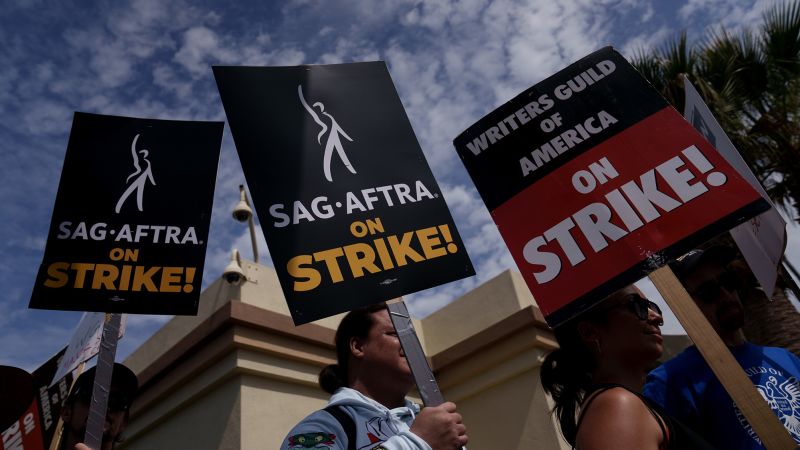Editor’s Note: A version of this story appeared in CNN Business’ Nightcap newsletter. To get it in your inbox, sign up for free, here.
“Forrest Gump” has never made a single penny for the studio that made it, despite selling over $300 million worth of tickets at the box office. “Return of the Jedi” was a similarly monumental financial flop. Same goes for at least one Harry Potter film. All of them wildly popular, yet wildly unprofitable. At least on paper.
At the heart of the biggest TV and film industry strike in more than 60 years is a dispute over how people should be paid. But the unique accounting standards that the industry has long relied on to make those calculations is anything but straightforward.
“Hollywood accounting,” as a concept, is so specific to the entertainment business it has its own Wikipedia page.
Accountants talk about Hollywood accounting like a kind of wayward cousin, partly because it diverges from the United States’ generally accepted accounting principles, or GAAP — the standard bookkeeping that most US companies adhere to.
And while experts say this kind of creative accounting is perfectly legal, the tactics involve some of the most fantastical fictions ever devised in Tinseltown.
“There are a lot of different tricks,” said Stephen Glaeser, an associate professor of accounting at the University of North Carolina at Chapel Hill. But the most basic version of Hollywood accounting goes like this:
- A studio sets up a subsidiary for each movie it wants to make, and agrees to pay the actors based on that subsidiary’s profits.
- To actually make the movie, the subsidiary inevitably takes on expenses — crew wages, craft services, set design, props etc.
- When the movie comes out, the subsidiary brings in revenue from ticket sales.
- Like in any business, the studio takes the revenue, subtracts the costs, et voilà, there’s your profit (or loss).
This is where it gets weird.
If the movie-making subsidiary makes a profit, the studio then charges the subsidiary — as in, the little company the big company owns, operates, and entirely controls — fees for distribution, advertising, and whatever else, Glaeser told me. And, of course, the subsidiary “agrees” to the new fees. Because it must.
The profits then go straight to the studio in the form of fee payments, so that, on paper, the subsidiary never makes any profit.
But that feels a little absurd, doesn’t it? Why would a red-blooded American corporation not be interested in making a profit?
Because actors and other creatives involved in making it have profit-sharing deals in their contracts. If there’s no profit, the studios don’t have to pay them out.
“This is why the advice is ‘take the gross,’” Glaeser said, echoing what any decent entertainment lawyer tells their client before signing on to a movie or series.
In other words, it’s on actors and writers to make sure any profit-sharing deals are tied to revenue or ticket sales, rather than net profit. No matter how successful the movie is, net profit may, by design, never exist.
Again, that’s all legal.
Where Hollywood accounting distinguishes itself from the kind of financial record-keeping most businesses engage in is the studios’ “overhead allocations,” or general operating expenses, said Bridget Stomberg, an accounting professor at Indiana University Bloomington.
“Some people suspect the overhead allocations to any one movie can be arbitrary and excessive with the goal of making movies look unprofitable,” she said.
But is it ethical?
“‘Ethical’ is not the word I would use,” Glaeser said. “I think studios that use these tricks are acting unethically, and maybe even foolishly. It seems like squeezing some extra profit out of one movie is not worth alienating some of your most important employees and contractors.”
Once a film is made, there are all kinds of expenses — distributing it widely to theaters, paid TV channels, streaming services, airlines, etc. There are also huge marketing costs and interest payments on debt, said S. Mark Young, an accounting professor at the University of Southern California’s Marshall School of Business.
“These costs add up quickly and often swamp the revenues from the film, resulting in zero profits or losses,” Young said. “What the studio is doing is within their purview … but certainly, there seems to be motivation on the part of some studios to reduce profits as much as possible.”
One oft-cited example is the 1997 hit “Men In Black,” starring Tommy Lee Jones and Will Smith. The movie grossed nearly $600 million on a budget of just $90 million. It was such a box-office winner, the movie spawned three sequels.
And yet Sony Pictures, the studio behind it, claims the film has never broken even.
The movie’s screenwriter, Ed Solomon, has spoken out about the accounting shenanigans that make that possible.
“The studios ARE losing money, just as they say,” he said recently in a deeply sarcastic tweet. “My recent Men in Black profit statement proves that the film, though having generated over $595 million in revenue, has actually *cost* Sony over $598 million. SO close, too: off by just .02%/yr.”
Sony, Solomon says, is artificially keeping the movie in the red to avoid big payouts.
“I think the profit statement is actually better science fiction than the film itself,” he joked in a 2019 tweet.
Sony didn’t immediately respond to a request from CNN for comment.
I asked Stomberg whether studios would have reasons for keeping their overhead costs inflated other than avoiding paying actors and writers.
“I can’t think of any other motivation,” she said in an email. “If these subsidiaries are US incorporated and are 100%-owned by the same company, there wouldn’t generally be any tax savings.”
Transactions between the studio and its subsidiary, she said, are generally eliminated when companies consolidate their earnings. That means all of these “creative” expense allocations shouldn’t affect what net profits the studio’s shareholders see.
Enjoying Nightcap? Sign up and you’ll get all of this, plus some other funny stuff we liked on the internet, in your inbox every night. (OK, most nights — we believe in a four-day work week around here.)
Read the full article here




